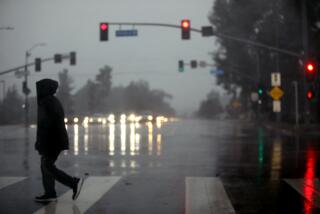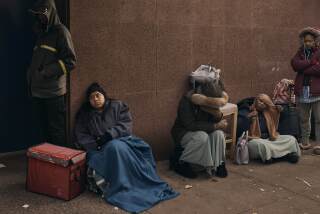In Brooklyn project, residents wait for help in the cold and dark
BROOKLYN, N.Y. — When Ulysses Bermudez hikes upstairs to check on his elderly neighbors in his public housing project, he is met by a fetid stench from people unable or afraid to go down the 14 dark flights to use portable toilets set up in the street.
“People can’t live like this,” he said.
But on Monday, a week after super storm Sandy slammed into New York, many still do. Hundreds of residents in the Red Hook West project, Brooklyn’s largest, are without heat, electricity, elevators or water. Garbage piles up in pitch-black hallways, food rots in freezers without power, and the darkened stairwells stink of urine.
FULL COVERAGE: East Coast hit by deadly storm
“When they finally get everything up and running, they’re going to have to get fire hoses in to clean this place out and make it livable again,” said Bermudez, 57. The housing complex dates from the 1950s, three red-brick high-rises in a gritty neighborhood less than a mile from Lower Manhattan.
Those who can leave have gone. But many, including the elderly, say they have nowhere to go. So they or their friends lug water up the stairs, and use bleach and plungers to flush their toilets. Most haven’t showered in a week.
“This is a disgusting way to live,” said Barbara Robinson, 73, before she trudged up 13 flights of stairs.
PHOTOS: Hurricane Sandy devastation
Sandy seemed to have hit New York’s public housing especially hard. Though many of the buildings hit by the storm have had power and heat restored, 35,000 people still need heat and hot water and 21,000 people live in buildings where electricity is still out.
So as nighttime temperatures drop to the 20s, and as forecasters warn a nor’easter is brewing in the Atlantic, residents sleep in hoodies, jackets and socks, and huddle under blankets handed out by charities. Some leave their ovens on at night to generate a little heat— risking fire or, if the pilot light goes out, a potentially lethal release of gas.
The contrast couldn’t be starker between the darkness on the edge of Brooklyn and the bright lights of Manhattan, where electricity has mostly returned.
“All I hear on the news is that the lights are back on in Manhattan,” said Carolyn Lee, 56. “You don’t hear anything about Red Hook.”
The deprivation has fed a growing despair among residents who say federal and state officials have forgotten the low-lying neighborhood in western Brooklyn, where Sandy’s huge tidal surge swallowed cars and flooded blocks more than half a mile inland. Several businesses were wiped out, and the Red Hook post office and the main elementary school have closed indefinitely.
National Guard troops and volunteers have fanned out to distribute food, water, batteries and other essentials. Utility company crews have restored power to some buildings, but most of Red Hook West, which normally is home to more than 3,300 people, remains in the dark.
When the sun is out, residents say, life is tolerable. Guided by flashlights, they climb down the dank stairwells and into the open air to visit emergency shelters for donated food and other assistance. Those who can afford it shop at the few local markets that have reopened.
For now, most residents have enough to eat. A nearby charity, the Red Hook Initiative, buzzed with dozens of volunteers — mostly from the hip, gentrified Brooklyn that has lured legions of young people in skinny jeans and perfect hair — serving hot meals and handing out toilet paper and other items.
But once the sun goes down, they say, Red Hook feels as sinister as it was back in the 1980s, when the crumbling former port was a casualty of New York’s crack epidemic. Rumors of burglaries and violent crimes swirl through the complex, and most people don’t venture out after dark.
“You can’t see your hand in front of your face, it’s so dark,” said Lee, who lives with her 5-year-old grandson. “When you see a light out there, you don’t know who’s there.”
In one of the high-rises, floodwater washed into the basement and appears to have knocked out the incinerator, so some people are leaving bags of garbage in the hallways and staircases.
The city set up portable toilets outside the building, but some residents still try to use their own toilets instead of walking up and down in the dark and bitter cold. For some, the mere arrival of the emergency facilities last week was a sign that the city didn’t expect conditions to improve any time soon.
“That was extremely depressing,” said Albert Barnes, 66. “It made me think the road to recovery would be slower than we could imagine.”
More to Read
Start your day right
Sign up for Essential California for news, features and recommendations from the L.A. Times and beyond in your inbox six days a week.
You may occasionally receive promotional content from the Los Angeles Times.







